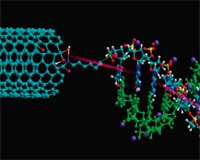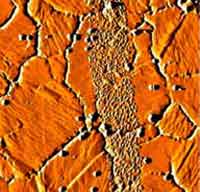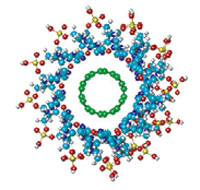Showing Spotlights 57 - 64 of 68 in category All (newest first):
 DNA, the blueprint of life, and electronics seem to be two completely different things but it appears that DNA could offer a solution to many of the hurdles that need to be overcome in further scaling down electronic circuits beyond a certain point. The reason why DNA could be useful in nanotechnology for the design of electric circuits is the fact that it actually is the best nanowire in existence - it self-assembles, it self-replicates and it can adopt various states and conformations. Not surprisingly, performing reliable experiments on a single oligo-DNA molecule is an extremely delicate task as partly contradicting research reports demonstrate: Different DNA transport experiments have shown that DNA may be insulating, semiconducting, or metallic. Among the numerous factors that could impact the results are the quality of the DNA-electrode interface, the base pair, the charge injection into the molecule, or environmental effects such as humidity or temperature. Researchers have now demonstrated a novel carbon nanotube-based nanoelectronic platform as proof of concept that single DNA molecules can be detected. This novel detection technique is based on change in electrical conductance upon selective hybridization of the complementary target DNA with the single stranded probe attached to the system. The single-stranded sequence-specific probe DNA whose ends are modified with amine is attached between two carbon nanotubes/nanowires using dielectrophoresis (DEP). This platform can be used for understanding how electrical charge moves through DNA which could help researchers understand and perhaps develop a technique for reversing the damage of DNA done by oxidation and mutation.
DNA, the blueprint of life, and electronics seem to be two completely different things but it appears that DNA could offer a solution to many of the hurdles that need to be overcome in further scaling down electronic circuits beyond a certain point. The reason why DNA could be useful in nanotechnology for the design of electric circuits is the fact that it actually is the best nanowire in existence - it self-assembles, it self-replicates and it can adopt various states and conformations. Not surprisingly, performing reliable experiments on a single oligo-DNA molecule is an extremely delicate task as partly contradicting research reports demonstrate: Different DNA transport experiments have shown that DNA may be insulating, semiconducting, or metallic. Among the numerous factors that could impact the results are the quality of the DNA-electrode interface, the base pair, the charge injection into the molecule, or environmental effects such as humidity or temperature. Researchers have now demonstrated a novel carbon nanotube-based nanoelectronic platform as proof of concept that single DNA molecules can be detected. This novel detection technique is based on change in electrical conductance upon selective hybridization of the complementary target DNA with the single stranded probe attached to the system. The single-stranded sequence-specific probe DNA whose ends are modified with amine is attached between two carbon nanotubes/nanowires using dielectrophoresis (DEP). This platform can be used for understanding how electrical charge moves through DNA which could help researchers understand and perhaps develop a technique for reversing the damage of DNA done by oxidation and mutation.
Dec 28th, 2007
 One of the many fascinating concepts in nanotechnology is the vision of molecular electronics. If realized, the shift in size from even the smallest computer chip today would be staggering - a quantum leap, so to speak (literally). Look at it this way: a single drop of water contains more molecules than the billions and billions of silicon chips ever produced. Molecular electronics engineers of tomorrow might use individual molecules to perform the functions in an electronic circuit that are performed by semiconductor devices today. Don't get your hopes up, though, that your next iPod will be truly nano. Scientists today are still struggling with the most basic requirements for molecular electronics, for instance, how to precisely and reliably position individual molecules on a surface. DNA-based nanostructuring is one approach that could lead to promising results. It has already been shown that DNA could be used to structure nanoscale surfaces. Now, a team in Germany has demonstrated that nanoscale objects of very different size can be deposited simultaneously and site-selectively onto DNA-displaying surfaces, based on sequence-specific DNA-DNA duplex formation.
One of the many fascinating concepts in nanotechnology is the vision of molecular electronics. If realized, the shift in size from even the smallest computer chip today would be staggering - a quantum leap, so to speak (literally). Look at it this way: a single drop of water contains more molecules than the billions and billions of silicon chips ever produced. Molecular electronics engineers of tomorrow might use individual molecules to perform the functions in an electronic circuit that are performed by semiconductor devices today. Don't get your hopes up, though, that your next iPod will be truly nano. Scientists today are still struggling with the most basic requirements for molecular electronics, for instance, how to precisely and reliably position individual molecules on a surface. DNA-based nanostructuring is one approach that could lead to promising results. It has already been shown that DNA could be used to structure nanoscale surfaces. Now, a team in Germany has demonstrated that nanoscale objects of very different size can be deposited simultaneously and site-selectively onto DNA-displaying surfaces, based on sequence-specific DNA-DNA duplex formation.
Aug 6th, 2007
 To achieve the full benefits of the amazing properties of carbon nanotubes (CNTs) researchers are exploring all kinds of CNT composite materials. Material engineers are interested because this will lead to lighter,stronger and tougher materials. Another fascinating area involves CNT/polymer composite structures that will lead to a vast range of improved and novel applications, from antistatic and EMI shielding to more efficient fuel and solar cells, to nanoelectronic devices. One particular area of CNT/polymer composites is dealing with DNA-CNTs hybrids. Although researchers expect a plethora of new applications, the fact that even the formation mechanism of these complexes is not yet clear shows how early in the game this research still is. This might be due to the fact that in spite of the quite large number of experimental investigations on the interaction between DNA and CNTs, the number of theoretical studies is limited. Researchers in Germany now present, for the first time, the results of a systematic quantum mechanical modeling of the stability and the electronic properties of complexes based on single-walled carbon nanotubes, which are helically wrapped by DNA molecules.
To achieve the full benefits of the amazing properties of carbon nanotubes (CNTs) researchers are exploring all kinds of CNT composite materials. Material engineers are interested because this will lead to lighter,stronger and tougher materials. Another fascinating area involves CNT/polymer composite structures that will lead to a vast range of improved and novel applications, from antistatic and EMI shielding to more efficient fuel and solar cells, to nanoelectronic devices. One particular area of CNT/polymer composites is dealing with DNA-CNTs hybrids. Although researchers expect a plethora of new applications, the fact that even the formation mechanism of these complexes is not yet clear shows how early in the game this research still is. This might be due to the fact that in spite of the quite large number of experimental investigations on the interaction between DNA and CNTs, the number of theoretical studies is limited. Researchers in Germany now present, for the first time, the results of a systematic quantum mechanical modeling of the stability and the electronic properties of complexes based on single-walled carbon nanotubes, which are helically wrapped by DNA molecules.
Jun 4th, 2007
 The success of nanorobotics requires the precise placement and subsequent operation of specific nanomechanical devices at particular locations, thereby leading to a diversity of structural states. The structural programmability of DNA makes it a particularly attractive system for nanorobotics. A large number of DNA-based nanomechanical devices have been described, controlled by a variety of methods. These include pH changes and the addition of other molecular components, such as small molecule effectors, proteins and DNA strands. The most versatile of these devices are those that are controlled by DNA strands. This versatility results because they can be addressed specifically by strands with particular sequences. Researchers at New York University have developed a framework that contains a binding site �?? a cassette �?? that allows insertion of a rotary device into a specific site of a DNA array, allowing for the motion of a nanorobotic arm. Changing the cassette�??s control sequences or insertion sequences allows the researchers to manipulate the array or insert it at different locations.
The success of nanorobotics requires the precise placement and subsequent operation of specific nanomechanical devices at particular locations, thereby leading to a diversity of structural states. The structural programmability of DNA makes it a particularly attractive system for nanorobotics. A large number of DNA-based nanomechanical devices have been described, controlled by a variety of methods. These include pH changes and the addition of other molecular components, such as small molecule effectors, proteins and DNA strands. The most versatile of these devices are those that are controlled by DNA strands. This versatility results because they can be addressed specifically by strands with particular sequences. Researchers at New York University have developed a framework that contains a binding site �?? a cassette �?? that allows insertion of a rotary device into a specific site of a DNA array, allowing for the motion of a nanorobotic arm. Changing the cassette�??s control sequences or insertion sequences allows the researchers to manipulate the array or insert it at different locations.
Jan 10th, 2007
 A large number of DNA-based nanomechanical devices have been described, controlled by a variety of methods: These include pH changes and the addition of other molecular components, such as small molecule effectors, proteins and DNA strands. The most versatile of these devices are those that are controlled by DNA strands: This versatility results because they can be addressed specifically by strands with particular sequences; these strands can be added to the solution directly, or perhaps they can result from another process ongoing within the local environment. Researchers have now shown that the state of a DNA-based nanomechanical device can be controlled by RNA strands, which means that nanomechanical devices could potentially be run from transcriptionally derived RNA molecules.
A large number of DNA-based nanomechanical devices have been described, controlled by a variety of methods: These include pH changes and the addition of other molecular components, such as small molecule effectors, proteins and DNA strands. The most versatile of these devices are those that are controlled by DNA strands: This versatility results because they can be addressed specifically by strands with particular sequences; these strands can be added to the solution directly, or perhaps they can result from another process ongoing within the local environment. Researchers have now shown that the state of a DNA-based nanomechanical device can be controlled by RNA strands, which means that nanomechanical devices could potentially be run from transcriptionally derived RNA molecules.
Dec 7th, 2006
 Recent developments in DNA-based nanotechnology have shown the suitability of this novel assembly method for constructing useful nanostructures. DNA molecules can serve as precisely controllable and programmable scaffolds for organizing functional nanomaterials in the design, fabrication, and characterization of nanometer scale electronic devices and sensors. DNA-templated metallic nanowires are such an example and over the past few years DNA scaffolds have been metallized with silver, gold, palladium, platinum and copper. DNA-based fabrication methods could ultimately lead to naturally bio-compatible nanodevices.
Recent developments in DNA-based nanotechnology have shown the suitability of this novel assembly method for constructing useful nanostructures. DNA molecules can serve as precisely controllable and programmable scaffolds for organizing functional nanomaterials in the design, fabrication, and characterization of nanometer scale electronic devices and sensors. DNA-templated metallic nanowires are such an example and over the past few years DNA scaffolds have been metallized with silver, gold, palladium, platinum and copper. DNA-based fabrication methods could ultimately lead to naturally bio-compatible nanodevices.
Aug 31st, 2006
 Researchers in South Korea used single-walled carbon nanotubes (SWNTs) to tag single-stranded DNA to locate a particular sequence of DNA within a complex genome. The results show that SWNTs may be used as generic nano-biomarkers for the precise detection of specific kinds of genes.
Researchers in South Korea used single-walled carbon nanotubes (SWNTs) to tag single-stranded DNA to locate a particular sequence of DNA within a complex genome. The results show that SWNTs may be used as generic nano-biomarkers for the precise detection of specific kinds of genes.
Jul 18th, 2006
 Researchers at the University of Illinois at Urbana-Champaign have shown that, by employing small pieces of DNA molecules called aptamers, nanomaterials can be smart enough to assemble or disassemble only in the presence of programmable signals such as AND or OR, with controllable cooperativity.
Researchers at the University of Illinois at Urbana-Champaign have shown that, by employing small pieces of DNA molecules called aptamers, nanomaterials can be smart enough to assemble or disassemble only in the presence of programmable signals such as AND or OR, with controllable cooperativity.
Jul 13th, 2006
 DNA, the blueprint of life, and electronics seem to be two completely different things but it appears that DNA could offer a solution to many of the hurdles that need to be overcome in further scaling down electronic circuits beyond a certain point. The reason why DNA could be useful in nanotechnology for the design of electric circuits is the fact that it actually is the best nanowire in existence - it self-assembles, it self-replicates and it can adopt various states and conformations. Not surprisingly, performing reliable experiments on a single oligo-DNA molecule is an extremely delicate task as partly contradicting research reports demonstrate: Different DNA transport experiments have shown that DNA may be insulating, semiconducting, or metallic. Among the numerous factors that could impact the results are the quality of the DNA-electrode interface, the base pair, the charge injection into the molecule, or environmental effects such as humidity or temperature. Researchers have now demonstrated a novel carbon nanotube-based nanoelectronic platform as proof of concept that single DNA molecules can be detected. This novel detection technique is based on change in electrical conductance upon selective hybridization of the complementary target DNA with the single stranded probe attached to the system. The single-stranded sequence-specific probe DNA whose ends are modified with amine is attached between two carbon nanotubes/nanowires using dielectrophoresis (DEP). This platform can be used for understanding how electrical charge moves through DNA which could help researchers understand and perhaps develop a technique for reversing the damage of DNA done by oxidation and mutation.
DNA, the blueprint of life, and electronics seem to be two completely different things but it appears that DNA could offer a solution to many of the hurdles that need to be overcome in further scaling down electronic circuits beyond a certain point. The reason why DNA could be useful in nanotechnology for the design of electric circuits is the fact that it actually is the best nanowire in existence - it self-assembles, it self-replicates and it can adopt various states and conformations. Not surprisingly, performing reliable experiments on a single oligo-DNA molecule is an extremely delicate task as partly contradicting research reports demonstrate: Different DNA transport experiments have shown that DNA may be insulating, semiconducting, or metallic. Among the numerous factors that could impact the results are the quality of the DNA-electrode interface, the base pair, the charge injection into the molecule, or environmental effects such as humidity or temperature. Researchers have now demonstrated a novel carbon nanotube-based nanoelectronic platform as proof of concept that single DNA molecules can be detected. This novel detection technique is based on change in electrical conductance upon selective hybridization of the complementary target DNA with the single stranded probe attached to the system. The single-stranded sequence-specific probe DNA whose ends are modified with amine is attached between two carbon nanotubes/nanowires using dielectrophoresis (DEP). This platform can be used for understanding how electrical charge moves through DNA which could help researchers understand and perhaps develop a technique for reversing the damage of DNA done by oxidation and mutation.
 Subscribe to our Nanotechnology Spotlight feed
Subscribe to our Nanotechnology Spotlight feed

